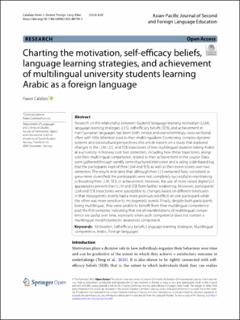| dc.contributor.author | Calafato, Raees | |
| dc.date.accessioned | 2024-04-18T12:44:06Z | |
| dc.date.available | 2024-04-18T12:44:06Z | |
| dc.date.created | 2023-07-07T13:55:45Z | |
| dc.date.issued | 2023 | |
| dc.identifier.citation | Calafato, R. (2023). Charting the motivation, self-efficacy beliefs, language learning strategies, and achievement of multilingual university students learning Arabic as a foreign language. Asian-Pacific Journal of Second and Foreign Language Education, 8, Artikkel 20. | en_US |
| dc.identifier.issn | 2363-5169 | |
| dc.identifier.uri | https://hdl.handle.net/11250/3127302 | |
| dc.description.abstract | Research on the relationship between students’ language learning motivation (LLM), language learning strategies (LLS), self-efficacy beliefs (SEB), and achievement in non-European languages has been both limited and overwhelmingly cross-sectional, often with little attention paid to their multilingualism. Combining complex dynamic systems and sociocultural perspectives, this article reports on a study that explored changes in the LLM, LLS, and SEB trajectories of two multilingual students taking Arabic at a university in Norway over two semesters, including how these trajectories, alongside their multilingual competence, related to their achievement in the course. Data were gathered through weekly semi-structured interviews and a rating scale-based log that the participants kept of their LLM and SEB, as well as their exam scores over two semesters. The results indicated that, although their LLS remained fairly consistent or grew more diversified, the participants were not completely successful in maintaining or boosting their LLM, SEB, or achievement. However, the use of more varied digital LLS appeared to prevent their LLM and SEB from further weakening. Moreover, participants’ LLM and SEB trajectories were susceptible to changes based on different timescales in that mesogenetic events had a more pronounced effect on one participant while the other was more sensitive to microgenetic events. Finally, despite both participants being multilingual, they were unable to benefit from their multilingual competence past the first semester, indicating that not all manifestations of multilingual competence are useful over time, especially when such competence does not contain a multilingual morphosyntactic awareness component. | en_US |
| dc.language.iso | eng | en_US |
| dc.rights | Navngivelse 4.0 Internasjonal | * |
| dc.rights.uri | http://creativecommons.org/licenses/by/4.0/deed.no | * |
| dc.title | Charting the motivation, self-efficacy beliefs, language learning strategies, and achievement of multilingual university students learning Arabic as a foreign language | en_US |
| dc.type | Peer reviewed | en_US |
| dc.type | Journal article | en_US |
| dc.description.version | publishedVersion | en_US |
| dc.rights.holder | © The Author(s) 2023. | en_US |
| dc.source.volume | 8 | en_US |
| dc.source.journal | Asian-Pacific Journal of Second and Foreign Language Education | en_US |
| dc.identifier.doi | https://doi.org/10.1186/s40862-023-00194-5 | |
| dc.identifier.cristin | 2161460 | |
| dc.source.articlenumber | 20 | en_US |
| cristin.ispublished | true | |
| cristin.fulltext | original | |
| cristin.qualitycode | 1 | |

